 Last additions - Nagoya 名古屋市 Last additions - Nagoya 名古屋市 |
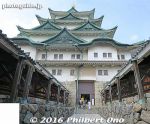
Corridor between the smaller tower and main tower.Sep 20, 2016
|
|
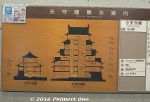
Museum inside Nagoya Castle's main tower had seven floors with exhibits. There was an elevator inside. The smaller tower had nothing except the door and entrance hall.Nagoya Castle's main tower closed on May 6, 2018 to be dismantled (and reconstructed).Sep 20, 2016
|
|

Sep 20, 2016
|
|

Sep 20, 2016
|
|

Sep 20, 2016
|
|

Entrance hallSep 20, 2016
|
|

Sep 20, 2016
|
|

Entrance to the main castle tower.Sep 20, 2016
|
|

Sep 20, 2016
|
|

Sep 20, 2016
|
|

Elevator for wheelchairs.Sep 20, 2016
|
|

Entrance to the main castle tower when it was still open. Nagoya Castle's main tower closed on May 6, 2018 to be dismantled (and reconstructed). Interior photos were taken when it ws still open.Sep 20, 2016
|
|

Sep 20, 2016
|
|

Sep 20, 2016
|
|

Sep 20, 2016
|
|

Sep 20, 2016
|
|

Nagoya Castle's main castle tower is paired with and connected to a lesser tower on the left. It is closed to the public and will be dismantled from fall 2019 for its grand reconstruction with wood to be completed in Dec. 2022.Sep 20, 2016
|
|

Sep 20, 2016
|
|

Sep 20, 2016
|
|

List of donors for building the Hommaru Palace.Sep 20, 2016
|
|

Sep 20, 2016
|
|

Sep 20, 2016
|
|

Some of the rocks on the stone walls are engraved with the crest of samurai clans that provided the stones and helped to build Nagoya Castle.Sep 20, 2016
|
|

Love the fine roof lines.Sep 20, 2016
|
|

Sep 20, 2016
|
|

Thin pieces of wood are stacked on the roof.Sep 20, 2016
|
|

Sep 20, 2016
|
|

Donations are welcome.Sep 20, 2016
|
|
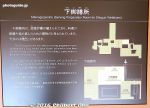
About the Preparation room (Shimo Gozensho) to serve the Reception Hall. 下御膳所Sep 20, 2016
|
|

Preparation room (Shimo Gozensho) to serve the Reception Hall. 下御膳所Sep 20, 2016
|
|

Sep 20, 2016
|
|

Another room of the Taimenjo (対面所) Reception Hall. 納戸二之間Sep 20, 2016
|
|

Sep 20, 2016
|
|

Sep 20, 2016
|
|

Another room of the Taimenjo (対面所) Reception Hall. 納戸一之間Sep 20, 2016
|
|

Sep 20, 2016
|
|

Sep 20, 2016
|
|

Inner courtyardSep 20, 2016
|
|

Sep 20, 2016
|
|

Sep 20, 2016
|
|

Sep 20, 2016
|
|

The Taimenjo (対面所) Reception Hall Sep 20, 2016
|
|

Very intricate overhead transom made of wood.Sep 20, 2016
|
|

Sep 20, 2016
|
|

The Taimenjo (対面所) Reception Hall.Sep 20, 2016
|
|

Paintings show scenes from Wakayama.Sep 20, 2016
|
|

Special latticed ceiling of the Taimenjo (対面所) Reception Hall's Jodan-no-Ma room reserved for the daimyo lord.Sep 20, 2016
|
|

Sep 20, 2016
|
|

The Taimenjo (対面所) Reception Hall is most impressive.Sep 20, 2016
|
|

This section is the Taimenjo (対面所) Reception Hall consisting of four rooms.Sep 20, 2016
|
|
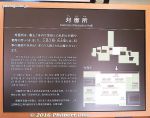
Sep 20, 2016
|
|

Sep 20, 2016
|
|

The Omote Shoin (表書院) Main Hall's Jodan-no-Ma Room which is reserved for daimyo. 上段之間.Sep 20, 2016
|
|

The Omote Shoin (表書院) Main Hall's Jodan-no-Ma Room which is reserved for daimyo of Nagoya Castle. 上段之間.Sep 20, 2016
|
|

Sliding door painting of birds in the Omote Shoin (表書院) Main Hall's Ichi-no-Ma Room 一之間.Sep 20, 2016
|
|

Sliding door painting in the Omote Shoin (表書院) Main Hall's Ichi-no-Ma Room 一之間.Sep 20, 2016
|
|

Sliding door painting in the Omote Shoin (表書院) Main Hall's Ichi-no-Ma Room 一之間. The main hall features paintings of flowers and birds.Sep 20, 2016
|
|

Omote Shoin (表書院) Main Hall's Ni-no-Ma Room 二之間.Sep 20, 2016
|
|

Sliding door lock.Sep 20, 2016
|
|

Sliding door painting in the Omote Shoin (表書院) Main Hall's Ichi-no-Ma Room 一之間. Nagoya Castle's Hommaru Palace.Sep 20, 2016
|
|

Sliding door painting in the Omote Shoin (表書院) Main Hall's Ichi-no-Ma Room 一之間.Sep 20, 2016
|
|

Omote Shoin (表書院) Main Hall's Ni-no-Ma Room 二之間.Sep 20, 2016
|
|
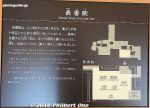
Sep 20, 2016
|
|

Corridor. All hinoki cypress wood, giving a pleasant aroma.Sep 20, 2016
|
|

Even the design of the tatami mats's edges are matched seamlessly.Sep 20, 2016
|
|

Sep 20, 2016
|
|

Omote Shoin (表書院) Main Hall's San-no-Ma Room 三之間.Sep 20, 2016
|
|

Omote Shoin (表書院) Main Hall's San-no-Ma Room 三之間.Sep 20, 2016
|
|

Next section is the Omote Shoin (表書院) Main Hall consisting of five rooms. This is the San-no-Ma 三之間.Sep 20, 2016
|
|

Sep 20, 2016
|
|

Next to the Ninoma room is the Genkan entrance hall’s Ichinoma room that includes an alcove. 18 tatami mats. 一之間Sep 20, 2016
|
|

Leopard at Nagoya Castle's Hommaru Palace.Sep 20, 2016
|
|

Sep 20, 2016
|
|

Sep 20, 2016
|
|

Paintings of mythical tigers and leopards. They are reproducing the artwork as faithfully as possible. An absolutely magnificent job. Really painstaking though, as they trace over original paintings. This palace is slated to be completed in 2018, after 9 years of work. The original palace took only 3 years to complete.Sep 20, 2016
|
|

Genkan entrance hall’s Ninoma room. The original painters were from the renown Kano school of painting. 28 tatami mats. 二之間Sep 20, 2016
|
|

All the paintings are painstakingly hand-painted replicas of the original art. Nagoya Castle's Hommaru Palace.They have excellent records and photos of the original palace (floor plans, etc.) so they are working to reconstruct the palace as close to the original as possible. Magnificent.Sep 20, 2016
|
|

The first section we see is the Genkan entrance hall consisting of two rooms next to the Kuruma Yose VIP entrance. This is the Ninoma room. 二之間Sep 20, 2016
|
|
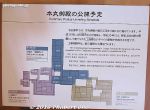
About half the palace has been completed and opened to the public.Sep 20, 2016
|
|

Sep 20, 2016
|
|

Corridor of the palace, made of fragrant hinoki cypress.Sep 20, 2016
|
|

Shoe lockers where you can store your footwear.Sep 20, 2016
|
|

When you first enter the Hommaru Palace, you're in a room called the Nakanokuchibeya (中之口部屋). Take off your footwear and backpacks, bags, etc., are required to be stored.Sep 20, 2016
|
|

Side entrance to the reconstructed palace. We can enter and tour the completed portion of the palace here. Have to take off your shoes. Photography is permitted, but flash is prohibited.Sep 20, 2016
|
|

Beam fixtureSep 20, 2016
|
|

Sep 20, 2016
|
|

The reconstructed palace uses the original foundation stones in their original place. Can't get more authentic than this.Sep 20, 2016
|
|

Sep 20, 2016
|
|

Elegant roof lineSep 20, 2016
|
|

This palace was modeled after the Nijo Castle palace in Kyoto, so it looks similar on a smaller scale. Both Nijo Castle and Nagoya Castle were connected to the Tokugawa shoguns.Sep 20, 2016
|
|

Sep 20, 2016
|
|

Nagoya's new Hommaru Palace is right next to the tenshukaku main castle tower.Sep 20, 2016
|
|

Inside the main entrance called "Kuruma Yose" 車寄 reserved for the castle lord and other VIPs.Sep 20, 2016
|
|

Ironically, the castle lord lived in the Honmaru Palace for only a short period before moving to the much larger Ninomaru Palace nearby. No plans to reconstruct the Ninomaru Palace.Sep 20, 2016
|
|

Photo of the original Hommaru Palace before it was destroyed during World War II.Sep 20, 2016
|
|

This humdrum-ness of Nagoya Castle is about to disappear as it is on track to regain its former glory as they reconstruct the original Honmaru Palace next to the main castle tower. Sep 20, 2016
|
|

What the Hommaru Palace will look like when completed.Sep 20, 2016
|
|

This photo was taken in July 2016 showing the main entrance (called "Kuruma Yose" 車寄 reserved for the castle lord and other VIPs) of the magnificent reconstructed Honmaru Goten Palace.Above the entrance is an architectural feature called "karahafu" which is a hump-shaped gable commonly seen on important buildings such as castles, temples, and palaces. Sep 20, 2016
|
|
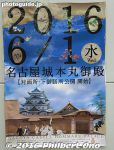
The palace is where the castle lord lived and worked, while the castle tower was usually just a storehouse and visual symbol of power and authority.Sep 20, 2016
|
|

Kiyomasa's stoneSep 20, 2016
|
|

Uchibori moatSep 20, 2016
|
|

Uchibori moatSep 20, 2016
|
|
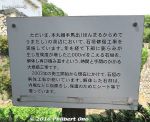
Sep 20, 2016
|
|

Rocks are temporarily stored here from another part of the castle wall being repaired.Sep 20, 2016
|
|

Kiyomasa depicted as the rock hauling director. When building the castle, many men had to push and pull large rocks into place. On top of a large boulder, a man would shout and direct the men to move.Sep 20, 2016
|
|

This American guy named Chris O'Neill is a member of Aichi's ninja troupe named "Tokugawa Ieyasu and Hattori Hanzo Ninja Squad" to promote tourism in the prefecture. They perform at Nagoya Castle and elsewhere. He was selected from 200 applicants from 40 countries. I ran into him when while exiting the castle. Too bad I didn't catch their show. He was very friendly. He's very good at doing these ninja stunts.
I have to compliment Aichi for forming such a PR troupe and including an amusing foreigner to boot. I'm sure they are getting their money's worth in terms of goodwill and good impressions on tourists. Sep 20, 2016
|
|

After I paid the admission and went in, there was a rack of pamphlets about the castle in various languages. As usual, I picked up the English and Japanese versions. Then this Japanese lady suddenly came up to me and said in English, "Hello, are you going to visit the castle?" I said, "Yes." She offered to be my volunteer guide. I told her that I could understand Japanese, but would be glad to have a guide anyway. So she guided me through the new palace and the castle tower for about 90 min. She serves as a volunteer guide once a week. I have to give my thumbs up to her and her volunteer group for being so hospitable to foreign visitors.Sep 20, 2016
|
|

East Gate ticket gateSep 20, 2016
|
|

Aichi Prefectural Gymnasium is within the castle grounds. It is also the venue for the Nagoya sumo tournament held in July. 愛知県体育館Sumo wrestlers were coming and going. These are low-ranking wrestlers who walk and take the subway like the rest of us. The high-ranking wrestlers travel by taxi or their own car. Sep 20, 2016
|
|

The drum tower on the left is for the sumo tournament.Sep 20, 2016
|
|

When I revisited in July 2016, the Nagoya Basho sumo tournament was underway.Sep 20, 2016
|
|

Nagoyajo subway station on the Meijo subway line. Nagoya Castle is near Nagoyajo Station (used to be named "Shiyakusho") which is also near Nagoya's city hall. This station exit has a castle motif.Sep 20, 2016
|
|
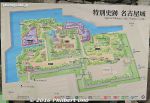
Sadly, the original buildings were destroyed by World War II firebombings by the US. The main castle tower was reconstructed with ferro-concrete in 1959. And now, since 2009, they are reconstructing the Hommaru Palace. They are using traditional materials and methods of construction.Sep 20, 2016
|
|
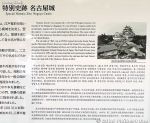
Nagoya Castle is Nagoya's most visible attraction and symbol of the city. It is most closely associated with the Tokugawa after Ieyasu decided to rebuild it in the early 1600s. Twenty daimyo lords from Western Japan were ordered to build the castle including Kato Kiyomasa who built Kumamoto Castle. It was the base of the Tokugawa's Owari branch. The main castle tower was paired with a smaller tower and the Hommaru Palace and Ninomaru Palace were built nearby.Sep 20, 2016
|
|

This is what we received for 1,000 yen. Some sweets as well. It also included a tea session. (See below.)Feb 18, 2009
|
|

Osu Niomon-dori shopping arcade.Feb 16, 2009
|
|

Ryukasui at Seijuin, monument for an old well.Feb 16, 2009
|
|

Beckoning cat, a popular meeting place.Feb 16, 2009
|
|

Feb 16, 2009
|
|

Feb 16, 2009
|
|

Entrance to Osu Niomon-dori shopping arcade.Feb 16, 2009
|
|

Osu Niomon-dori shopping arcade.Feb 16, 2009
|
|

Temple bellFeb 16, 2009
|
|

Altar of Osu Kannon Temple's Hondo main hall.Feb 16, 2009
|
|

Entrance to Kannon-dori shopping arcade.Feb 16, 2009
|
|

Feb 16, 2009
|
|

Inside the Hondo main hall of Osu Kannon Temple.Feb 16, 2009
|
|

Monument for Taisho koto.Feb 16, 2009
|
|

View from the Hondo main hall.Feb 16, 2009
|
|

Feb 16, 2009
|
|

Porch of the Hondo main hall.Feb 16, 2009
|
|

Hondo main hall of Osu Kannon Temple. However, there is an elevated platform for the Setsubun bean throwers. These photos were taken a few days before Feb. 3.Feb 16, 2009
|
|

Large paper lantern at the entrance of the Hondo main hall.Feb 16, 2009
|
|

Osu Kannon Temple 大須観音Feb 16, 2009
|
|

Incense burnerFeb 16, 2009
|
|

Feb 16, 2009
|
|

Niomon Gate, the front gate of Osu Kannon Temple. 仁王門Feb 16, 2009
|
|

Omotesando path to the temple. Very few people walk along this main path because it is not in the direction of the nearest subway station.Feb 16, 2009
|
|

Niomon Gate Feb 16, 2009
|
|

West side of Osu Kannon Temple. The space on the right is where you can have your car blessed (for a fee) by the temple priest for traffic safety.Feb 16, 2009
|
|

West Gate of Osu Kannon Temple. This is the gate nearest to the subway station. Note that this is not the main gate even though it is the most popular one. 西門Feb 16, 2009
|
|

Get your car blessed here for transportation safety.Feb 16, 2009
|
|

My bowl of matcha green tea. After we consumed the tea, we just left. The shrines also has many other buildings, but it was too crowded for me to see them all this day. I was too tired walk around more.Jan 18, 2009
|
|

There was no ceremony. We just sat and were served tea and sweet.Jan 18, 2009
|
|

The shrine maidens came around to serve the tea and sweet.Jan 18, 2009
|
|

A sweet confection to eat with the matcha tea.Jan 18, 2009
|
|

The stage was appropriate for New Year's.Jan 18, 2009
|
|

This is the Bunkaden Culture Hall which is behind and attached to the Treasure Hall. This is where they held the tea session.Jan 18, 2009
|
|

Inside the Bunkaden Culture Hall for tea.Jan 18, 2009
|
|

Behind and attached to the Homotsukan Treasure Hall is the Bunkaden Culture Hall where they held a tea session. People form a long line as they wait to enter the Bunkaden. The tea was included in the 1,000 yen I paid to see the inner shrine.Jan 18, 2009
|
|

Follow the sign to exit or to see other shrine buildings.Jan 18, 2009
|
|

Homotsukan Treasure Hall houses and exhibits the shrine's valuable artifacts, including Important Cultural Properties and a National Treasure (a dagger). Many people donated stuff to the shrine, especially swords. 宝物館Jan 18, 2009
|
|

Remnant of the Nobunaga-bei, a roofed mud wall donated to the shrine in 1560 by Oda Nobunaga in gratitude for his victory at the Battle of Okehazama.Jan 18, 2009
|
|

Built in 1686 by Shogun Tsunayoshi, this is Nishi-gakusho, one of the few shrine buildings remaining from before the Meiji Period. Dances and other ceremonies are held here. 西楽所Jan 18, 2009
|
|

Omikuji fortune paper.Jan 18, 2009
|
|

Jan 18, 2009
|
|

Description of various amulets in English.Jan 18, 2009
|
|

Jan 18, 2009
|
|

Jan 18, 2009
|
|

Jan 18, 2009
|
|

Jan 18, 2009
|
|
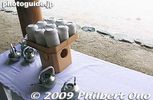
They also give you a small dish and sake served by a shrine maiden as you exit.Jan 18, 2009
|
|

Shrine amulets were selling like crazy.Jan 18, 2009
|
|

Shrines are in the business of selling good fortune and hope.Jan 18, 2009
|
|

Votive tablets and other trinkets.Jan 18, 2009
|
|

I wonder how much money these wallets contain.Jan 18, 2009
|
|

View of the money pit as seen from the shrine. This is still quite small compared to Meiji Shrine in Tokyo on New Year's Day. Less crowded too.Jan 18, 2009
|
|

Jan 18, 2009
|
|

The shrine's bank will love to count all this money. It must be their favorite time of year.Jan 18, 2009
|
|
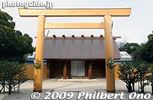
Atsuta Jingu Shrine's Hongu main shrine. For 1,000 yen, they let you in here to pray. The architecture and layout are almost the same as the Ise Grand Shrines in Mie Pref. Rebuilt in 1955. I wonder if the sacred sword is in there.Jan 18, 2009
|
|

Jan 18, 2009
|
|

Jan 18, 2009
|
|

New Year's prayers at Atsuta Jingu Shrine on Jan. 1.Jan 18, 2009
|
|

Jan 18, 2009
|
|

Now we stand in line to pray before the shrine.Jan 18, 2009
|
|

Getting closer.Jan 18, 2009
|
|

Coins, bills, gift certificates, and even wallets were thrown in here.Jan 18, 2009
|
|

The police were holding back the crowd at regular intervals before they could enter the shrine's worship area.Jan 18, 2009
|
|

This is what we wanted to see. The offertory pit where people throw their money in front of the Hongu main shrine. 本宮Jan 18, 2009
|
|

Standing in line to pray.Jan 18, 2009
|
|

Jan 18, 2009
|
|

Approaching the final torii.Jan 18, 2009
|
|

Finally, the shrine is in sight.Jan 18, 2009
|
|

We want to go straight.Jan 18, 2009
|
|

We stand still.Jan 18, 2009
|
|

Barrels of sake.Jan 18, 2009
|
|

From the ladle, pour the water into your hand and sip the water to purify yourself before visiting the shrine. This was a most crowded place.Jan 18, 2009
|
|

We got to the wash fountain to purify ourselves.Jan 18, 2009
|
|

Atsuta Shrine was established about 1900 years ago. In the centuries past, the shrine has been patronized by major historical figures such as Oda Nobunaga, Toyotomi Hideyoshi, and the Tokugawa shoguns (Ieyasu was originally from this area).Jan 18, 2009
|
|

The East torii gate of Atsuta Jingu Shrine, made of wood. Atsuta Jingu worships Atsuta-no-Ookami or Amaterasu-Omikami, the Sun Goddess represented by Kusanagi-no-tsurugi, the sacred sword.Jan 18, 2009
|
|

The crowd thickens and it was stop and go, repeatedly.Jan 18, 2009
|
|

Wash fountainJan 18, 2009
|
|

One normal gate was closed and we all had to enter through the East Gate.Jan 18, 2009
|
|

Banner read "Happy New Year."Jan 18, 2009
|
|

This is where the crowd begins on New Year's Day. The shrine also worships four other deities: Susanoo-no-mikoto, Yamato-Takeru-no-Mikoto, and Takeinadane-no-Mikoto and Miyasuhime-no-Mikoto, the parents of the Owari natives (Nagoya area).Jan 18, 2009
|
|

Another train station near Atsuta Shrine is Meitetsu Jingumae Station (this is closer than Atsuta Station). 名鉄神宮前駅Jan 18, 2009
|
|

The road in front of Meitetsu Jingumae Station was closed to traffic, allowing pedestrians to get to Atsuta Shrine on New Year's Day.Jan 18, 2009
|
|

Many food stalls line the way to the shrine on New Year's Day.Jan 18, 2009
|
|

We soon hit a bottleneck where we had to wait a while as we slowly got nearer to the shrine.Jan 18, 2009
|
|

Atsuta Jingu is one of Japan's most important shrines as it enshrines one of the three Imperial Regalia of Japan, the sacred (and perhaps legendary) sword called Kusanagi-no-Tsurugi ("Grass Cutting Sword"). 草薙の剣Jan 18, 2009
|
|

I always visit a different shrine on New Year's Day, so for 2009, I visited Atsuta Jingu Shrine in Nagoya. JR Atsuta Station on the Tokaido Line is one train station near Atsuta Jingu Shrine. JR熱田駅Jan 18, 2009
|
|

Shopping arcade on the way to the shrine from Atsuta Station.Atsuta Jingu is near Meitetsu Jingumae Station, JR Atsuta Station on the Tokaido Line, Atsuta Jingu Nishi Station (renamed from Jingu Nishi Station on Jan. 4, 2023) on the Meijo subway line, and Atsuta Jingu Tenma-cho Station (renamed from Tenma-choStation on Jan. 4, 2023) on the Meijo subway line.Jan 18, 2009
|
|
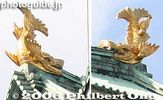
Symbol of Nagoya, golden shachihoko. Killer whale or fish with a tiger's head.First believed to protect the building from disasters, but later served as the symbol of the castle lord's authority. The original pair was destroyed along with the castle tower during WWII, but they were remade in 1959 along with the castle tower. Later, they were recoated with gold. They gleam very well on sunny days. The male fish is on the right (north), and female (south) on the left.Jan 27, 2006
|
|

Jan 21, 2006
|
|

Northwest corner turret. Also called the Inui or Kiyosu Turret. Very photogenic with the wide moat in front. 戌亥櫓(いぬいやぐら)、清洲櫓、西北隅櫓Jan 21, 2006
|
|

Dry moat on east side of castle.Jan 21, 2006
|
|

North side of castleJan 21, 2006
|
|

Outside Seimon GateJan 21, 2006
|
|
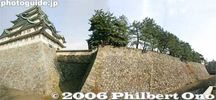
Jan 21, 2006
|
|

West side near the Uzura no Kubi inletJan 21, 2006
|
|

Jan 21, 2006
|
|

Nagoya Castle, Northwest corner turret. 西北隅櫓Jan 21, 2006
|
|

On the 5th floor was a model of shachihoko that you could touch and sit on for pictures.Nagoya Castle's main tower closed on May 6, 2018 to be dismantled (and reconstructed).Jan 21, 2006
|
|

Seimon Gate (reconstructed in 1959). The gate was destroyed during WWII, and was reconstructed in 1959 together with the castle tower. 正門Jan 21, 2006
|
|

Jan 21, 2006
|
|

Jan 21, 2006
|
|

Castle tower and southwest corner turret.未申櫓, 西南隅櫓Jan 21, 2006
|
|

Northwest corner turret. 西北隅櫓Jan 21, 2006
|
|

Site of palace building before it was rebuilt. Only foundation stones remained.Jan 21, 2006
|
|

West side of Nagoya CastleJan 21, 2006
|
|

Nagoya Station's twin towers in the distance.Jan 21, 2006
|
|

This photo was taken in 2006, showing an empty lot where the Hommaru Goten Palace is being reconstructed now.Jan 21, 2006
|
|

Inside castle towerThe castle tower is a history museum.Jan 21, 2006
|
|

Seimon Gate 正門Jan 21, 2006
|
|

Southwest corner turret 西南隅櫓Jan 21, 2006
|
|

Closeup of castle tower, with shachihoko on top. Nagoya Castle is famous for its golden pair of shachihoko roof ornaments. During the Aichi Expo in 2005, they were taken down for public display. 天守閣Jan 21, 2006
|
|

This photo from 2006 shows an empty lot next to the main castle tower.Jan 21, 2006
|
|

Jan 21, 2006
|
|

Palace foundation stones. The palace, destroyed during WWII, served only as luxury lodging for the shogun passing through. The architecture was similar to the palace at Nijo Castle.Jan 21, 2006
|
|

Gift shop on top floorJan 21, 2006
|
|

Jan 21, 2006
|
|

Stone wall cornerJan 21, 2006
|
|

Omote Ni-no-mon Gate (Important Cultural Asset). Entrance where most people enter the castle's center. 表二之門Jan 21, 2006
|
|

Reconstructed in 1959 in ferro-concrete, Nagoya Castle's main tenshu tower has closed on May 6, 2018 to start its monumental reconstruction. 天守閣This main tower used to house a museum. The top floor had a lookout deck with fine views. Jan 21, 2006
|
|

Picture taken in 2006. 天守閣Jan 21, 2006
|
|

Sotobori moat 外堀Jan 21, 2006
|
|

Kiyomasa depicted as the rock hauling director. When building the castle, many men had to push and pull large rocks into place. On top of a large boulder, a man would shout and direct the men to move.Jan 21, 2006
|
|

This is Nagoya Castle when I visited in 2006. In the foreground, you can see the stone foundations of the Honmaru Palace still remaining.Jan 21, 2006
|
|

Although Nagoya Castle is impressive, it never had the pizazz or aura of being anything special compared to other major castles (especially the National Treasures) in Japan.Mainly because the main castle tower is a 1950s ferro-concrete reconstruction of the original National Treasure that sadly got destroyed by WWII fire bombings. It has been a relatively humdrum castle, and people in Nagoya knew it.Jan 21, 2006
|
|

Southeast corner turret (Important Cultural Property)東南隅櫓Jan 21, 2006
|
|

Southeast corner turret東南隅櫓Jan 21, 2006
|
|

Southeast corner turret (Important Cultural Property). Also called the Tatsumi Yagura turret. It has bay windows to drop stones. 辰巳櫓 東南隅櫓Jan 21, 2006
|
|

To East GateJan 21, 2006
|
|

East Gate ticket gate. Nagoya Castle admission is ¥500 for adults. Open 9 am to 4:30 pm. Closed Dec. 29–Jan. 1.Jan 21, 2006
|
|

As you walk toward the castle entrance, you see this Sotobori outer moat.Jan 21, 2006
|
|

Bridge across the Sotobori moat to East Gate 東門Jan 21, 2006
|
|

Near the station is Nagoya City Hall (Shiyakusho) which also sports a castle motif.Jan 21, 2006
|
|
|
|
|